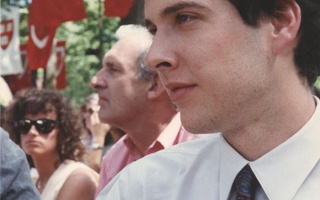
Actors stage a fight scene in Shakespeare’s “Troilus and Cressida,” the first show performed at Loeb Drama Center on October 15, 1960.
In the late 1950s, George C. Izenour, a pioneer of theater technology, was invited to a conference in New York City to consult on the construction of the New York Metropolitan Opera House. Izenour told his audience of top theater specialists about his ideas for a black box theater, specialized rigging systems, moving seat wagons, and electronic lighting boards.
“Everyone pooh-poohed him and told him he was crazy,” said Donald R. Soule, the original technical director at the Loeb Drama Center and assistant to Izenour. “The only person he seemed to impress was Harvard English professor Robert Chapman. Chapman called him up the next day and I answered the phone.”
Shortly thereafter, Izenour and Robert H. Chapman, who would become the first director of the Loeb, met in a small New Haven coffee shop where, on the back of a napkin, Izenour drew up the plans for what would become the Loeb.
While the theater scene on campus was thriving even before the completion of the Loeb in 1960, the state-of-the-art facility opened up new opportunities and eventually the chance for students to work alongside a professional theater company.
‘EVERYTHING ON OUR OWN’
Before the Loeb was constructed, student productions were a highly self-sufficient affair.
“We were extremely independent,” said Joel F. Henning ’61, former president of the Harvard Dramatic Club. “Was that was fun? Yes, absolutely. We got to do everything on our own, but the Loeb Drama Center changed all of that.”
Students involved in productions rented costumes, sets, and lighting equipment without help from the College. But this hands-on learning experience also led to some headaches.
“I forgot that Memorial Drive had huge oak trees hanging over it,” Henning said. “We were trucking a set to Agassiz and one of the oaks knocked it right off the truck into the middle of Memorial Drive.”
With the Loeb’s on-site scene shop and new rigging technology, students would no longer have to rely on rentals. However, access to such expensive and advanced equipment came with a price—a new non-student chain of command.
“We wanted to do some summer productions so we had to go be interviewed by President Pusey,” Charles W. Hayford ’63 said. “We didn’t really have control over the building.”
“Now, this is an institution. I couldn’t just say, ‘Hey let’s just do XYZ play,’” Henning said. “You had to go to Chapman, apply, and present all your ideas.”
Despite increased University control over the building and the introduction of professionals to run the space, alumni insisted that for the most part the Loeb was a positive addition to the dramatic arts on campus.
“It was a little more structured and a little bit more institutionalized. There were other [non-student] minds, but very creative minds, which were coming up with proposals,” Henning said. “But was it agony? Was it a hopeless bureaucracy? Certainly not.”
LEARNING THE ROPES
Read more in News
Speaker Pushes For Creativity at Business School Class DayRecommended Articles
-
A House as a HomeI never shared in enough Kirkland experiences to become a genuine part of that community, but I did find my own affiliation elsewhere.
-
 Harvard Researchers Discover Hypervelocity Planets
Harvard Researchers Discover Hypervelocity Planets -
Study: Extraterrestrial Life May Be Detectable Near White DwarfsIf extraterrestrial life exists near dying stars, there may be a way to detect it within the next decade, according to a new theoretical study co-authored by Harvard astronomy professor Abraham “Avi” Loeb.
-
 A.O. Scott
A.O. Scott -
 Harvard Today: February 20, 2014
Harvard Today: February 20, 2014 -
50 Years After "Big Bang" Theory, Experts Discuss Universe's Origins, FutureTo commemorate the 50th anniversary of research validating the "big bang," experts from Harvard and elsewhere spoke Thursday.















